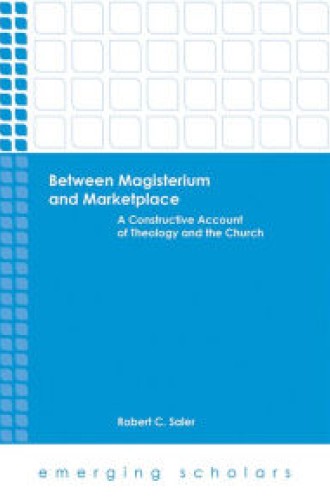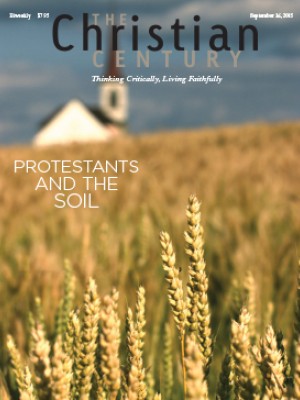Between Magisterium and Marketplace, by Robert C. Saler
When the Catholic Church’s Extraordinary Synod on the Family convened last year to discuss theologically fraught issues from divorce and cohabitation to homosexuality, an unusually public debate swirled around it. What is theological truth, people asked, and where does the authority reside to define it? In an essay called “Why I Am a Catholic,” New York Times columnist Ross Douthat argued that the “search for authority in Christianity” began with the need to know what had been taught by Jesus and the apostles, rather than with “pre-emptive submission to an established hierarchy.”
It’s a chicken-and-egg theological question: Is there a Christian truth that is prior and external to the teaching ministry that proclaims it? By briefly suggesting a shift in doctrine supported by impeccably magisterial teaching authority, the Synod on the Family brought that question to the fore.
Read our latest issue or browse back issues.
In making his own case for doctrinal and disciplinary stability in the area of divorce, Douthat distinguished himself from a considerable body of fellow converts, mostly from Anglican and Lutheran churches, whose explanations suggest a search for authority expressed by an established hierarchy. These authors, including Paul Griffiths, R. R. Reno, Reinhard Hütter, and Leonard Klein, collectively suggest by their conversions that a crisis is afoot in the world of confessional, theologically catholic Protestantism.
This crisis is not strictly an illusion, Lutheran theologian Robert Saler suggests in Between Magisterium and Marketplace: A Constructive Account of Theology and the Church. The relationship between how we conceive of theological authorship and how we conceive of the church—Saler’s two main concerns—is particularly unsettled. Theological authorship is increasingly authorized by the norms of academic publishing and hiring or by the marketplace writ large, rather than by the norms of a distinct and identifiable church. It is this new marketplace that creates the profusion of theologies inflected by race, gender, and ethnicity, as well as their libidinous cultural cognates, which so many of these recent converts from Protestantism have found offensive. Saler summarizes the alternative expressed by these writers as “high-magisterial polis ecclesiology,” which seeks to locate authentic theology in a “concrete, visible, unified and magisterially underpinned” public, namely the church. In this understanding the church can, with its own norms, resist the corrosive power of the anarchic marketplace.
Saler finds the contemporary authorial problem foreshadowed in the works of two pairs of theological writers: Thomas More and William Tyndale during the Reformation, and John Henry Newman and Friedrich Schleiermacher in the late 18th and early 19th centuries. The debates—literal and violent in the case of More and Tyndale, figurative and conflated in the case of Newman and Schleiermacher—are at once distant and familiar. With More and Newman we see painfully tautological arguments from authority; with Tyndale and Schleiermacher, conceptions of theological virtuosity that threaten to escape any norm whatsoever.
It is the latter threat, of an unbounded and market-driven theological authorship, that drives polis ecclesiology toward Newmanesque conclusions. In this view, as Saler puts it, “ecclesiology precedes epistemology”: an a priori commitment to a concrete and visible public, including its hierarchically constituted teaching authority, shapes all theological speech and guards it from the disintegration of the marketplace and the cultural liberalism of the mainline churches. Even Radical Orthodoxy, as proposed by theologians like Stanley Hauerwas and John Milbank, requires a certain heroic individualism to survive and thus can’t satisfy the need for authority expressed in the high-magisterial view.
But is an ecclesially diverse and fragmented landscape of theological authorship necessarily a bad thing? Are the theologies coming out of African, Latin American, Asian, feminist, LGBT, and other contexts really a sort of philosophical shopping spree, as polis ecclesiologists from Hütter to Joseph Ratzinger seem to indicate? Is a concrete, visible, continuous, and magisterially governed body the only way church can be reliably discerned in the world?
In his last chapter Saler proposes an alternative to the church as polis that he calls “church as diffusively spatialized event.” Drawing on the work of Vitor Westhelle and Joseph Sittler, Saler describes the church not as the exclusive home of the Spirit’s working or as the space of redemption, but as an ongoing and creative response to ecological and cultural realities it cannot fully circumscribe. He writes:
If the catholicity of redemption is a present and not simply a future reality, then we must be prepared to find the church outside of those spaces which label themselves as “church,” and we must be prepared to see redemption in events that are just as likely to disrupt as to affirm the status quo of both religion and society.
For that purpose, a “weak” and diffuse church is a help and not a hindrance. A theological authorship that extends God’s “otherness” to humans who occupy “very different discursive contexts . . . from those of a given theological author” can grasp truths in a profusion that is unintelligible to a more centralized ecclesiology.
A wide and powerful erudition makes this book dense and sometimes breathless reading. It was tempting to imagine a more leisurely and panoramic itinerary, from the death-of-the-author theory of Roland Barthes to the expressionist ecclesiology of Karl Barth. This dialogue between literary theory and theology is more than welcome, but by the end the book seems to be more about ecclesiology and theology than about authorship. Yet even on those terms, Saler’s book does something desperately needed: it makes a positive case for the role of theological and ecclesial pluralism. Theological authorship inescapably implies a conception of church, and although some of us may wish to avoid choosing between conceptions of church as starkly distinct as polis and event, there may prove to be no third way.







